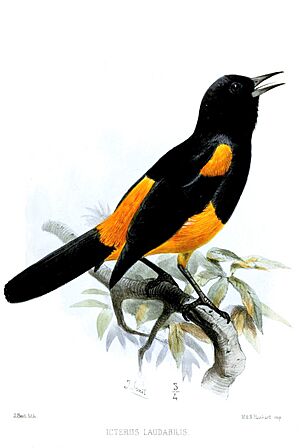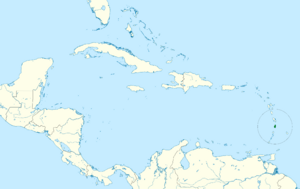Saint Lucia oriole facts for kids
Quick facts for kids Saint Lucia oriole |
|
|---|---|
 |
|
| Conservation status | |
| Scientific classification | |
 |
Meet the Saint Lucia Oriole (Icterus laudabilis), a special kind of bird! It belongs to the Icteridae family, also known as American Orioles. This beautiful bird lives only on the island of Saint Lucia. It's the only oriole that calls Saint Lucia home all year round.
Contents
Where the Saint Lucia Oriole Lives
Saint Lucia Orioles like to live in different kinds of forests. You can find them in mountain rainforests, which are wet and green. They also live in dry forests near the coast. Sometimes, they are seen at the edges of farms, like those growing bananas, citrus fruits, or coconuts. They even live in mangrove swamps, especially near the coast.
These birds seem to like the wet mountain forests more than the dry coastal ones. You can find them from sea level all the way up to 700 meters (about 2,300 feet) high.
What the Saint Lucia Oriole Looks Like
The Saint Lucia Oriole is a slim bird with a long beak. Most of its body is black. But it has bright patches of reddish-orange on its shoulders, lower back, belly, and under its tail. The top part of its beak is straight.
Boy and girl orioles look quite similar. The females might have slightly lighter orange patches. Young orioles look different! They are mostly chestnut brown. Where the adults have orange, the young birds have a golden-olive color.
These birds are about 20 to 22 centimeters (8 to 8.7 inches) long from head to tail. They weigh around 36.9 grams, which is about as much as 7 teaspoons of sugar. The males have a wingspan of about 98.7 millimeters (3.9 inches). Females have a slightly smaller wingspan, around 94.0 millimeters (3.7 inches).
How the Saint Lucia Oriole Behaves
Saint Lucia Orioles are good at finding food. They eat both fruits and insects. Sometimes, they even pull bark off trees to find insects hiding underneath. This is similar to how the Jamaican Oriole finds its food.
Nesting and Reproduction
These orioles build a special kind of nest. It hangs down and looks like a basket. They weave it together using plant fibers. You can often find their nests under big banana leaves or in coconut palm trees.
Female orioles usually lay 2 to 3 eggs at a time. The male bird does not feed the female while she is nesting. However, he might help feed the baby birds once they hatch. Nesting usually happens from April to early June.
The Song and Calls of the Oriole
The song of the Saint Lucia Oriole is a series of whistles. Each whistle lasts about two seconds. They play these whistles in a sequence. We don't know if they have many different songs or if they just repeat the same one. Their song is a bit like the Orchard Oriole's song, but it's not as strong.
They also have two distinct calls. One is a harsh sound that sounds like chwee. The other is a soft sound that sounds like chup.
Protecting the Saint Lucia Oriole
Sadly, the number of Saint Lucia Orioles has been going down. They are harder to find now and live in fewer places. Because of this, they are listed as Endangered on the IUCN Red List. Experts think there are just over 1,000 adult birds left.
Many things can threaten these birds. Losing their habitat (the places they live) is a big problem. Pesticide spraying, which are chemicals used on farms, can also harm them. Another threat is a bird called the shiny cowbird (Molothrus bonariensis). Shiny cowbirds lay their eggs in other birds' nests, and the cowbird chicks can push out the oriole chicks. More studies are needed to understand how much these things affect the Saint Lucia Oriole population.


